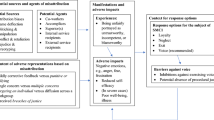Abstract
Unionized workers at a factory were asked to rate a variety of reasons which would justify the use of sabotage in an organization, as well as the justifiability of four general methods of sabotage (slowdowns, destructiveness, dishonesty, and causing chaos). Results showed that as compared to those who didn't accept a wide variety of reasons for sabotage, those who accepted a variety of reasons would more readily justify all forms of sabotage except dishonesty. The data is discussed in terms of the reasons for the lack of justification that dishonesty receives, as well as future directions for the study of sabotage.
Similar content being viewed by others
References
Allen, V. L., & Greenberger, D. B. (1980). Destruction and perceived control. In A. Baum and J. E. Singer (Eds.),Advances in Environmental Psychology. (Vol. 2), Hillsdale: Erlbaum.
Arkin, R. M. (1981). Self-presentational styles. In J. T. Tedeschi (Ed.),Impression Management Theory and Social Psychological Research. New York: Academic.
Bandura, A. (1979). The social learning perspective: Mechanisms of aggression. In H. Toch (Ed.) Psychology of crime and criminal justice. New York: Holt, Rinehart & Winston.
Bandura, A. & Kupers, C. (1964). Transmission of patterns of self-reinforcement through modeling.Journal of Abnormal and Social Psychology, 69, 1–9.
Baron, R. A. (1977).Human aggression. New York: Plenum.
Berkowitz, L. (1970). Experimental investigations of hostility catharsis.Journal of Clinical and Counseling Psychology, 35, 1–7.
Baumeister, R. (1982). A self-presentational view of social phenomena.Psychological Bulletin, 91, 3–26.
Buss, A. H. & Durkee, A. (1957). An inventory for assessing the different kinds of hostility.Journal of Consulting Psychology, 21, 522–528.
Christie, R. & Geis, F. (Eds.) (1970).Studies in Machiavellianism. New York: Academic.
Crowne, D. P. & Marlowe, D. (1964).The approval motive. New York: Wiley.
Deutsch, M., & Krauss, R. M. (1962). Studies in interpersonal bargaining.Journal of Conflict Resolution, 6, 52–76.
Dubois, P. (1980).Sabotage in industry. Harmondsworth, U.K.: Penguin.
Evans, M. K. (1984). Symbolic interactionism: A framework for the study of cultural mechanisms in organizations.Proceedings of the 21st Annual Meeting of the Eastern Academy of Management, 21, 163–166.
Felson, R. B. (1978). Aggression as impression management.Social Psychology, 41, 205–213.
Freedman, J. (1969). Role-playing: Psychology by consensus.Journal of Personality and Social Psychology, 13, 107–114.
Katz, D., & Kahn, R. L. (1978).The social psychology of organizations. New York: Wiley.
Mead, G. H. (1934).Mind, self, and society. Chicago: University of Chicago Press.
Mitchell, T. R. (1982).People in organizations. New York: McGraw-Hill.
Pfeffer, J. (1981). Management as symbolic action: The creation and maintenance of organizational paradigms. In B. Staw (Ed.),Research in organizational behavior. Greenwich, Ct.: JAI Press.
Schlenker, B. R. (1980).Impression management. Monterey, Ca.: Brooks/Cole.
Schlenker, B. R. (Ed.) (1985).The self and social life. New York: McGraw-Hill.
Scott, M. R., & Lyman, S. M. (1968). Accounts.American Sociological Review, 33, 46–62.
Semin, G. R., & Manstead, A.S.R. (1983).The accountability of conduct: A social psychological analysis. London: Academic.
Snyder, C. R., Higgins, R. L., & Stucky, R. J. (1983).Excuses: Masquerades in search of grace. New York: Wiley.
Snyder, M. (1979). Self-monitoring processes. In L. Berkowitz (Ed.),Advances in experimental social psychology. (Vol. 12). New York: Academic.
Terris, W. (1985).Employee theft: theory, research and applications. Park Ridge, IL: London House Press.
Toch, H. (1969).Violent men. Chicago: Aldine.
Zillman, D. (1979).Hostility and aggression. Hillsdale, N.J.: Erlbaum.
Author information
Authors and Affiliations
Rights and permissions
About this article
Cite this article
Giacalone, R.A., Rosenfeld, P. Reasons for employee sabotage in the workplace. J Bus Psychol 1, 367–378 (1987). https://doi.org/10.1007/BF01018145
Issue Date:
DOI: https://doi.org/10.1007/BF01018145




